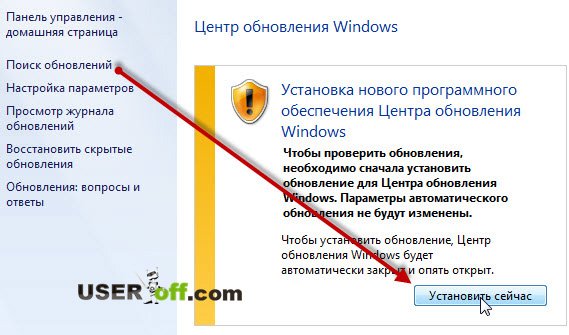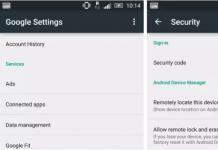Windows updates fix vulnerabilities in previous versions of the system, increase the speed of the computer, and often expand the user experience. If they are not installed, then in the future this can lead to errors in the operation of both individual applications and programs, and the OS itself.
Popular problems with updating Windows 10
Users are most concerned about:
- Windows 10 update will conflict with their antivirus program;
- disk space will run out, especially if the internal storage of a tablet or PC / laptop is small in volume (models of devices in the lower price range).
Antivirus preventing Windows update
The effect of antiviruses on Windows updates is explained by conflicts between a third-party antivirus (Kaspersky, ESET Smart Security, etc.) with the Windows Defender component (“Windows Defender”), originally built into the OS itself and updated along with it.
Timely updating of anti-virus programs and their databases
It is recommended to use the latest versions of antiviruses. For example, Kaspersky software requires versions of Kaspersky Anti-Virus, Kaspersky Internet Security and Kaspersky Total Security 2016 or 2017. In addition, you should not forget to update the operating system in a timely manner in order to avoid failures in installing Windows updates.
Update your antivirus, whether it's paid or freeIn 2015, when updating Windows 8.1 to Windows 10 or installing KIS 2015 on a ready-to-use Windows 10, Kaspersky Internet Security experienced the following problems:
- KIS 2015 did not work on Windows 10 Phone;
- KIS did not interact with the Microsoft Edge browser;
- without the Zero Day Patch component and the Device Guard function, network attack protection, advanced heuristics, and RAM checking did not work.
These problems have now been resolved.
It happens that Windows 10 updates are installed successfully, but the antivirus crashes. In these cases, it is worth updating it rather than waiting for new updates for your operating system.
Effect of antivirus on Windows 10 firewall settings
Any antivirus can disable the Windows 10 firewall, without which updates will no longer be installed, since the Windows Firewall and Automatic Updates components have been interconnected since the days of Windows XP. But the antivirus can be configured so that it does not add pre-installed applications and Windows system components to the list of blocked programs, among which there may be a built-in firewall.
To re-enable the firewall, do the following:

If Windows Firewall does not respond at all, then the Windows Firewall service is disabled. Do the following:

It is also possible that the firewall will turn on only after the complete removal of a third-party antivirus program.
Radical measures to resolve the conflict between antivirus and OS updates
If the conflict between the antivirus and updates cannot be resolved, there are two ways:
- abandon third-party antiviruses altogether, relying on Windows Defender (“Windows Defender”) and OS updates. After all, Windows Defender is already 10 years old, it was developed along with Windows Vista and is intended to complement the Windows firewall that has existed since the days of Windows XP. Since then, it has been modernized and updated several times. Install all cumulative updates and fixes related to ridding the user of online threats;
- sort through all anti-virus programs (there are more than a dozen of them), without focusing on products specifically from Kaspersky Lab or Avast, and find a conflict-free anti-virus package. This is the most difficult, but also the most advanced way to solve the problem.
Some laptops with Windows Vista installation discs included the MCAfee Virus Scan antivirus, a utility that complemented the capabilities of Windows Defender at the level of protecting the OS from network attacks, and a package of general fixes for Windows Vista. All of these tools are up to date and compatible with Windows 10, give them a try.
Video: Do I need an antivirus in Windows 10
Not enough disk space to update Windows
This issue affects low end tablets and netbooks with only 16GB or 32GB of storage (small HDD/SSD).
 SD-cards and flash drives 64 and 128 GB, installed in the PC of the lower price range, surpass the built-in media in terms of volume
SD-cards and flash drives 64 and 128 GB, installed in the PC of the lower price range, surpass the built-in media in terms of volume An example is updating Windows 10 to build 1607.
 Windows 10 updates take a while to download and install
Windows 10 updates take a while to download and install Windows 10 will report a lack of free space and recommend "unloading" the main drive or connecting another one (except for the USB-DVD-RW drive).
 Windows 10 will not be able to install updates if there is not enough free space on the disk
Windows 10 will not be able to install updates if there is not enough free space on the disk Windows does not collect obsolete updates, cluttering up the main disk, but replaces some with newer ones that have come out to replace or in addition to the old ones. At the same time, free space on the main disk can both be freed up and reduced to a small extent.
To be able to write down all the previous system data in case of a "rollback", use additional disks and flash drives. Do the following:

You now have a fully working Windows 10 system with fixes and additions installed.
 The system information contains the version (code) of the update
The system information contains the version (code) of the update If the update version code has not changed to the one you were updating, then the process failed. Look for another reason for rejection.
Video: How to prepare drive C for downloading new Windows 10 updates
Windows 10 updates not installing
There are several reasons for this problem.
Windows updates are downloading but not installing
Starting with Windows XP, the automatic update setting was reduced to four values:
The second option is the most irrational. Why download something that will not be installed and will soon become outdated, because update packages are released monthly and stably, and a significant part of them are defense against network threats. This option should have been removed altogether.
In Windows 10, you cannot opt out of some updates, unless you use the "Command Prompt", "Registry Editor" or settings in the "Windows Local Group Policy Editor". In the standard settings called from the main menu, there is only automatic and delayed installation of updates. Do the following:

kb3213986 update not installing
This is a cumulative update that upgrades Windows 10 build to 14393.223. As of July 2017, it is considered obsolete. If this update fails to install, try its corrected and updated version kb3197356.
 If you are having problems installing the kb3213986 batch file, try its corrected version, kb3197356
If you are having problems installing the kb3213986 batch file, try its corrected version, kb3197356 Windows 10 users have had instances where the kb3213986 update installed to 7% and then reset. In older versions of Windows, an uninstalled batch file would not be completely removed, which would force you to urgently reinstall the system.
kb3213986 is a continuation of the kb3206632 update, without which kb3213986 simply cannot be installed. To view a list of installed updates, do the following:
- Right-click on the "Start" button and select "Programs and Features" from the menu that opens.
 Open Windows Programs and Features to get to updates
Open Windows Programs and Features to get to updates - A window of installed programs will open, click on the link "View installed updates".
 The list of installed updates will allow you to track problematic ones among them.
The list of installed updates will allow you to track problematic ones among them. - The window that opens will indicate which updates were installed and when.
 Using the list of successful updates, you can calculate those that failed to install them
Using the list of successful updates, you can calculate those that failed to install them
This way you can "find out" the problem that caused a particular update to fail, and send this information to Microsoft.
Whatever the update header code is - at least kb3213986, at least kb9999999 - the problem in half of the cases lies in previous updates installed before the current one. Windows is not just a system, but a system with subtle relationships that are broken due to non-observance of the sequence of installation of programs and additions to them, indicated in the description of each of the updates.
The following measures may help:
- “Rollback” Windows 10 to one of the previous dates in the recovery marks calendar;
- resetting Windows 10 to its original settings (the one in the .iso image from which the installation was carried out);
- reinstalling Windows 10;
- clearing uninstalled updates from the cache.
Try downloading and installing the "incorrect" update again. Most likely the problem will be resolved.
Windows 10 March 2017 Update won't install
Not only Windows 10, but also versions of Windows XP/2003/8 closed for the “update” were to receive Microsoft update 17-010, developed against the latest high-profile virus, the WannaCry ransomware.
 The WannaCry ransomware encrypts all data on the computer and requires a certain amount of money to decrypt it.
The WannaCry ransomware encrypts all data on the computer and requires a certain amount of money to decrypt it. Versions of Windows not supported by the MS17-010 update:
- Windows 8;
- Windows XP SP3;
- Windows XP SP2 64-bit;
- Windows Server 2008 for Itanium-based Systems;
- Windows Vista;
- Windows Server 2008;
- Windows XP Embedded;
- Windows Server 2003;
- Windows Server 2003 Data Center Edition.
If your OS version does not support MS17-010, then there are two ways:
- Please use update kb4012598.
- Change the OS version to any of these:
- Windows Vista Service Pack 2;
- Windows Server 2008 Service Pack 2;
- Windows 7 Service Pack 1;
- Windows Server 2008 R2 Service Pack 1;
- Windows 8.1;
- Windows Server 2012;
- Windows Server 2012 R2;
- Windows RT;
- Windows 10;
- Windows Server 2016.
Other reasons, as noted earlier, are so unique that they can only be solved on the spot with the direct support of Microsoft.
Windows 10 can't complete the update
It happens that the user downloaded updates, the installation started successfully, but the attempt to update ended with a “rollback” of Windows due to some errors.
 If the update ended with a "rollback" of Windows, other batch files are required
If the update ended with a "rollback" of Windows, other batch files are required Do the following:

Now, when you re-install the same update, the failure will disappear.
Windows 10 stopped updating
The cause may be a software or hardware failure, an improper shutdown, or a sudden reset of Windows. At the root of the problem is damage to settings due to improper shutdown of the Windows registry, errors on the disk, etc.
Fixes "Update" Windows 10 using the wizard
Try the standard troubleshooting wizard first.
- Follow the path: "Start" - "Control Panel" - "Troubleshooting" - "System and Security" - "Windows Update".
 Windows Troubleshooter fixes "Update" errors
Windows Troubleshooter fixes "Update" errors - Run Windows 10 Update.
- Click the Advanced button.
 Click on the "Advanced" button to open advanced OS troubleshooting settings
Click on the "Advanced" button to open advanced OS troubleshooting settings - Make sure auto-correction is active, click on the link to run as administrator.
 Run troubleshooting as an administrator
Run troubleshooting as an administrator - Wait for the Windows Update troubleshooting to finish.
 Troubleshooting your computer can take several minutes or more
Troubleshooting your computer can take several minutes or more - Close the program when it finishes troubleshooting.
 Close the Windows 10 Troubleshooter if the problem is resolved
Close the Windows 10 Troubleshooter if the problem is resolved
If this did not work, try to solve the problem using the "Command Prompt".
Fixing Windows 10 Update with Command Prompt
- Launch Windows Command Prompt with administrator rights.
- Enter these commands one by one:

- Register 25–36 DLLs in the registry. Their number may vary depending on the build of Windows. If one fails or is not found, move on to the next one. Each file is opened with the regsvr32.exe registry handler. List of DLL files that need to be registered:

- Empty the update cache on drive C by entering the commands "rmdir %systemroot%/SoftwareDistribution /S /Q" and "rmdir %systemroot%/system32catroot2 /S /Q".
 To properly clear the update cache, follow the sequence of entering commands
To properly clear the update cache, follow the sequence of entering commands - Restart the previously interrupted Windows 10 update services by typing the commands:

- Reset WinSock (network settings) by entering the commands:
- "ipconfig /flushdns";
- "netsh winsock reset";
- netsh winsock reset proxy.
- Close Command Prompt and restart Windows 10.
Most likely, the first Windows update will be successfully downloaded and installed.
Other Windows 10 update errors
There are a number of errors that the following methods are suitable for correcting.
Error 0xC1900101
This is a driver installation error with different attributes:
- 0xC1900101 - 0x20004;
- 0xC1900101 - 0x2000c;
- 0xC1900101 - 0x20017;
- 0xC1900101 - 0x30018;
- 0xC1900101 - 0x3000D;
- 0xC1900101 - 0x4000D;
- 0xC1900101 - 0x40017.
To solve you need:
- Update all your drivers.
- Disable devices that are no longer needed.
- Check for erroneous (under-installed or not installed at all) devices in the Windows Device Manager.
- Temporarily remove third-party antiviruses that interfere with the operation of devices for which driver installation ended with error 0xC1900101.
- Serve drive C (cleanup, defragmentation, disk check).
- Fix Windows 10 system files (requires installation media).
Errors 0xC1900208 - 0x4000C
The reason is the presence of programs that are incompatible with Windows 10 and its latest updates. Uninstall those questionable apps and try updating Windows again.
The update is not applicable to this PC
All (or some of them) important and critical updates have not been installed. Check which ones and install them. Try to install this update, most likely, the issue will be resolved.
Updates installed but not configured
You need an update code that could not be configured - it is logged in the Windows 8.1 or Windows 10 log. Address this code by creating a problem ticket on the Microsoft website.
Video: Windows 10 update errors with codes and how to fix them
Whatever the problems with Windows updates, you can successfully deal with them. The main thing to remember is that the more complex the problem, the more complex the approach.
Good day, friends! Everyone probably knows that by updating software products, you not only expand the capabilities of the updated program, but also improve the security of your computer as a whole. Sometimes, during this procedure, different situations arise, so I decided to touch on the topic of why Windows 7 updates are not installed. There may not be so many reasons when an update does not occur in Windows 7.
In this article I will try to tell you about everything as concisely and accessible as possible. With other versions of Windows, everything is the same, with the exception of some subtleties (for example, in XP, Windows Update opens a little differently). However, I think that this is not essential, so let's go!
Diagnosing a problem with a utility from Microsoft
Trying to restart the process manually! To do this, as the first option, you can try downloading the Windows Update Troubleshooter from the official website of Microsoft. To download the utility, we need to go to the official website, link.
Now you need to click on the image with a little man holding a key in his hands to download this program.

Then install it on your computer. Check the box "Accept", now click "Next".

When the utility is installed, you can try to update Windows 7. That is, as you understand, no further user intervention is required, since the program does everything automatically.

Checking system settings
If the method above did not help you, then let's start setting up Windows for updating without any additional downloads. To do this, we follow this path: "Start" - "Control Panel" - "System and Security".
Next, click on Windows Update. On the left side of the screen there is an inscription: "Search for updates", click on this item. Wait a bit, after which the “Install Now” button will appear on the right, which, as you understand, you need to click on to proceed with their installation.

Lots of requests
If you still can’t fix the problem, then close all windows that relate to Windows Update and try to try again in 20 minutes. In the meantime, you can read the article further.
You can also wait for the scheduled update to occur. If it is not configured for you, then we will do it now. To do this, click on the "Settings" on the left.

Check the boxes everywhere and select "Install updates automatically (recommended)". Specify a convenient time for you to download and install updates.

Remember to click "OK" to apply all the above steps.
Proxy Server
It is possible that you are trying to download updates via the Internet at your place of work. But admins, having closed the ports on which updates are downloaded, confuse this task.
To check this, you can take a computer or laptop to your home and try to do it through your Internet. If you have a computer, then there is no point in carrying this colossus, then go to the administrator and talk about the situation that has arisen. Tell him about the steps you have taken so that he understands that his help is urgently needed now.
Means of protection and viruses
Do you have a firewall or antivirus installed? Then, before updating, you must disable all security-related software products. It is possible that they are blocking communication with Microsoft servers.
Viruses can be the reason when updates for Windows 7 are not installed. To check your computer for viruses, download a free utility or. These programs do not require installation and are intuitive to use. If any viruses are found, then safely remove them.
If there is a firewall, then add an exclusion rule for these sites:
http://*.update.microsoft.com
https://*.update.microsoft.com
http://download.windowsupdate.com
If there are errors during the update
If you encounter errors while updating Windows, then this tool will come in handy. To download the fix, go to . By the way, on the same page, after they talk about how this utility works, there are also some recommendations that relate to my article.
Like last time, click on the image with a little man, download the utility and install it on your computer. How to download and how to install the program can be seen clearly a little higher, but I think you remember everything.
Minor Issues
If you still have the question of why Windows 7 updates are not being installed, remains unresolved, check the free space on your hard drive. No matter how trite and stupid it may sound, but in my practice there was such a case when the C: drive was completely full, and the user also wanted to load it with updates for Windows 7.
By the way, for the system to work stably, on drive C: you should have 3-5 GB of free space. A little digression, but this is a really important point for users.
Do you have unlicensed Windows? Are you using a pirated version? Then this problem might be due to illegal software. If you are in this situation, then just forget about any updates.
Of course, in order to download updates, you must have an Internet connection. Check if your internet connection has been interrupted. You can also close all - all programs, even those that do not belong to the Internet.
So I have listed all the main problems in the system that could interfere with updating Windows. I sincerely hope that you found a solution that fixed the situation.
Installing updates to your operating system improves its performance, security, and capabilities. But there are situations when it is simply impossible to perform it for the operating system. In this article, we will look at ways to help solve this problem.
Fix it program
The first way is to use the Fix it program. This utility was developed by Microsoft and is designed to troubleshoot Windows Update problems. Download and install the program on your computer. By clicking on the link, you can download the program from the official Microsoft website and familiarize yourself with the basic installation steps. Fix it works automatically, so after installing it, just repeat the installation of updates for Windows.
Enabling automatic mode
The second way is to check if automatic installation is enabled for them. To do this, go to "Start" - "Control Panel"- "System" .


In the settings window, from the drop-down list, select "Install ... automatically". A little lower you can configure what day of the week, and at what time they will be searched, downloaded and installed. Click OK to save your settings.

Update manually
The third way is to install updates manually. To do this, go to "Start" - "Control Panel"- "System" - "Windows Update". In this window, click "Search ...". Then you need to wait a bit and press the button "Install Now".

Overloaded site
The fourth way is that update errors occur due to overloaded websites. In this case, you need to wait 20 minutes and repeat the search again. Usually the problem goes away.
Various bugs
The fifth way - when installing updates, errors may occur. For information about the causes of the error, follow the link "Get help for this error". If you do not have such a link, you can simply enter the error code into a search engine and find information on the Internet. They are usually caused by an unstable internet connection. Check if the computer or laptop is connected to the Internet and search again. You can also use the Fix it program.

Viruses and Defenders
The sixth way is to check your computer for viruses and disable security programs. Sometimes it is the presence of viruses that will not allow you to install updates on your computer. Check your computer for viruses and remove any problems found. You can also try disabling antivirus protection and Windows Firewall during installation.
Not enough hard disk space
The seventh way is the availability of free space on the system disk. The fact is that in order to download and install them, there must be at least 3 GB of free space on the system disk. This is also necessary for the normal operation of the Windows operating system.
I hope the problem is solved, and in the future you will update your operating system without any problems.
Watch a video on the topic:
Rate article:
Installing updates to your operating system improves its performance, security, and capabilities. But there are situations when it is simply impossible to perform it for the operating system. In this article, we will look at ways to help solve this problem.
Fix it program
The first way is to use the Fix it program. This utility was developed by Microsoft and is designed to troubleshoot Windows Update problems. Download and install the program on your computer. By clicking on the link, you can download the program from the official Microsoft website and familiarize yourself with the basic installation steps. Fix it works automatically, so after installing it, just repeat the installation of updates for Windows.
Enabling automatic mode
The second way is to check if automatic installation is enabled for them. To do this, go to "Start" - "Control Panel"- "System" .


In the settings window, from the drop-down list, select "Install ... automatically". A little lower you can configure what day of the week, and at what time they will be searched, downloaded and installed. Click OK to save your settings.

Update manually
The third way is to install updates manually. To do this, go to "Start" - "Control Panel"- "System" - "Windows Update". In this window, click "Search ...". Then you need to wait a bit and press the button "Install Now".

Overloaded site
The fourth way is that update errors occur due to overloaded websites. In this case, you need to wait 20 minutes and repeat the search again. Usually the problem goes away.
Various bugs
The fifth way - when installing updates, errors may occur. For information about the causes of the error, follow the link "Get help for this error". If you do not have such a link, you can simply enter the error code into a search engine and find information on the Internet. They are usually caused by an unstable internet connection. Check if the computer or laptop is connected to the Internet and search again. You can also use the Fix it program.

Viruses and Defenders
The sixth way is to check your computer for viruses and disable security programs. Sometimes it is the presence of viruses that will not allow you to install updates on your computer. Check your computer for viruses and remove any problems found. You can also try disabling antivirus protection and Windows Firewall during installation.
Not enough hard disk space
The seventh way is the availability of free space on the system disk. The fact is that in order to download and install them, there must be at least 3 GB of free space on the system disk. This is also necessary for the normal operation of the Windows operating system.
I hope the problem is solved, and in the future you will update your operating system without any problems.
Watch a video on the topic:
Rate article:
Although Microsoft no longer supports the Windows 7 operating system, it still releases security updates for it. The question of why updates are not installed is very relevant. This article will provide answers for fixing common problems.
Disabled automatic update
A common reason that Windows 7 does not find updates is to turn off auto-update in the settings. Enabling this feature is quite simple:
It happens that no checkbox on the taskbar. Then you can solve the problem in another way:
- To do this, go to "Start", select " Control Panel»;
- Further " system and safety»;
- then select from the list Enable or disable automatic updates».
Incorrect download of updates
It is possible to fix the error of incorrect download of updates for Windows in the following way:

After that, you can start the re-installation.
Registry problems
The reason that Windows 7 is not updated may be a registry failure. You can fix it like this:

Update service not working properly
Some problems with installing packages are related to the service responsible for downloading them. The failure is fixed in several ways:

If the process fails to start again, you will need to perform additional steps:

Not enough hard disk space
Problems can be quite primitive, such as lack of hard disk space. Installation services require minimum 5 GB free space.
The solution to the problem is quite simple. Required to be removed unnecessary files and programs from the system disk. To do this, you can use the standard Windows 7 tools, for example, "" located in the control panel. 
Internet problems
Problems with the Internet connection can be the reason why updates are not installed:

Damage to the storage of system components
It happens that problems can be caused by damage to system components. The reasons may be lots of:
- 0x800B0101 - failed to install the certificate;
- 0x8007371B - transaction distribution error;
- 0x80070490 - error of a non-existent or deleted update file;
- 0x8007370B - error identifying object properties;
- 0x80070057 - parameters error;
- 0x800736CC - element matching error;
- 0x8007000D - data initialization error;
- 0x800F081F - Missing required files.
The above are the most common errors that occur when system components are damaged. There are several ways to resolve.
One of the most effective is installationWindows 7 in update mode. This option is characterized by the correction of most errors, while it will save personal files and system settings.
For this would need:

When you run this command, the system will check the integrity of the files and be able to restore them. If the data is restored, you can start the installation again.
Error 643
This failure depends on the Microsoft NET Framework service. To solve a software problem, you will need to do the following:
The second option involves uninstalling this component and reinstalling it.
Other Solutions
In addition to the above methods of fixing a failure when installing updates using system tools, you can use additional software.
Using Microsoft FixIt
To fix failures, you will need the Fixit utility, created by the manufacturer of the operating system. It fixes crashes related to the operation of the "Update Center".
After downloading the software, you need to install it. During this, the program will automatically create restore point. The utility will search for crash data and attempt to fix the files.
Clearing the cache
In some situations, Windows 7 does not look for updates due to boot problems. The essence of the process is that the files are loaded into the cache memory and stored there until the user starts their installation:

Running an update manually
To manually start, you will need to call the "Win + R" utility and enter the query " wapp". In the window that opens, select "". In the "Important" section, select the first installation option. Thus, the user will manually install updates. 



































